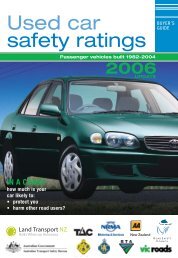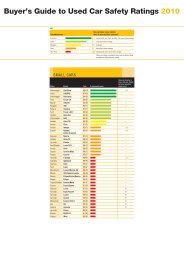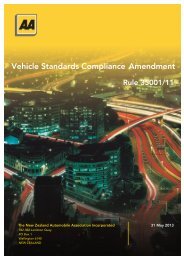ASSESSING FITNESS TO DRIVE
ASSESSING FITNESS TO DRIVE
ASSESSING FITNESS TO DRIVE
Create successful ePaper yourself
Turn your PDF publications into a flip-book with our unique Google optimized e-Paper software.
<strong>ASSESSING</strong> <strong>FITNESS</strong> <strong>TO</strong> <strong>DRIVE</strong><br />
A matter of risk ?
Why Do Occupational Therapists Undertake<br />
Driving Assessments<br />
In a nutshell<br />
• Occupational Therapists are interested in how people function<br />
and interact with their environment on a day to day basis<br />
especially those mundane everyday activities we all take for<br />
granted and do without a second thought<br />
• Driving for the majority of people is a routine daily activity.<br />
• The objective is if at all possible to keep people driving rather<br />
than reduce their independence.
The purely medical issues<br />
related to fitness to driving<br />
are the responsibility of the<br />
Physicians not the Occupational<br />
Therapists
Occupational Therapists become involved with driving primarily<br />
related to three issues:<br />
1) An individual’s ability to drive and the need for vehicle modifications<br />
2) An individual's cognitive function related to driving<br />
3) To a lesser extent some vision problems especially related to grey areas around<br />
visual fields<br />
Driving related to physical ability and cognitive function<br />
is all about risk
The chance of bad consequences<br />
Exposure<br />
To the<br />
risk of injury
What’s Up Officer ?
Valet Parking
What our Office Manager does off duty
Was the head not screwed on the right way<br />
round ?
Driving Assessment is an exercise in risk<br />
assessment and management<br />
Are They Safe To Drive<br />
Yes<br />
No<br />
A range of well, sort of depending…
Physical Driving Ability<br />
Where an individual has a physical<br />
deficit (excluding vision) in many<br />
cases the technology exists to<br />
compensate for that deficit.<br />
These include a range of<br />
modifications from the simple to<br />
the technologically advanced.<br />
Arms and legs are not required to<br />
drive.
Modifications range from a simple knob on the steering wheel through to EMC joystick<br />
steering<br />
Steering and Indicator Extension<br />
Left Hinged Accelerator Pedal
Menox Hand Control<br />
Cullen Hand Control
Cognitive Function Related to Driving<br />
Cognitive function related to driving is the most difficult area to assess<br />
and the one with the greatest potential for disaster.
What Does The Assessment Involve<br />
A two part assessment involving<br />
An Off Road Driving Assessment<br />
An On Road Driving Assessment
The Off Road Assessment<br />
The Off Road Assessment is designed to assess a<br />
number of areas:<br />
We need to know:<br />
• Where the client normally drives?<br />
• What type of car they drive?<br />
• Is their Driver’s Licence current?<br />
• Are there any residual physical<br />
problems which may affect driving?<br />
- Hemiparesis<br />
- Tone<br />
- Functional movement<br />
- Co-ordination<br />
- Sensation etc<br />
Vision – Visual Field Deficits<br />
If present then a referral is made to<br />
an Optometrist for visual field<br />
testing, that is does the individual<br />
have the required 140 of<br />
horizontal visual field to drive. If<br />
not then no driving.
Cognitive Function<br />
A computer based assessment called the CanDAT<br />
(the Canterbury Driving Assessment Tool)
What Does The CanDAT Assess ?<br />
• Visuomotor Skills/Visuoperceptual Skills<br />
• Reaction Time<br />
• Speed of Information Processing<br />
• Movement Speed<br />
• Visual Spatial Ability<br />
• Divided Attention<br />
• Complex Attention<br />
• Planning
What Do The Results Mean ?<br />
In addition to the overall impaired pass/fail/no clear result the<br />
individual sub tests can be indicative of potential problems<br />
related to in terms of driving in familiar areas versus unfamiliar<br />
and low complexity versus high complexity
The On Road Assessment<br />
Lets go for a drive…..<br />
The On Road drive is undertaken in the<br />
individual’s own car or one of the<br />
assessment cars if required.<br />
The assessment is undertaken by a Driving<br />
Instructor and the Occupational Therapist.<br />
The Driving Instructor’s job is to give<br />
directions and “risk manage”, that is<br />
intervene in the driving if required.<br />
The Occupational Therapist marks the<br />
assessment sheet
The drive begins in the individual’s own area and covers places where they would<br />
normally drive.<br />
Part of the assessment drive will be in less familiar areas and will involve<br />
different driving situations such as the local shopping area, suburban and<br />
back streets, and the motorway or highway if appropriate.
The On Road Assessment is NOT a driving test of the type required to sit or<br />
retain a Driver’s Licence.<br />
The assessment focus is on a range of behaviours which can be associated with<br />
cognitive function.<br />
These include<br />
• The ability to apply priority rules<br />
•The ability to make a decision in a reasonable time acting appropriately<br />
•Observe and recognise signs (includes knowing you are at a give way or stop sign).<br />
•Reacting in time to hazards, i.e. late braking for other vehicles, intersections, bends in<br />
the road, pedestrians, including inappropriate stopping for empty pedestrian crossings<br />
and intersections<br />
•Selecting correct lanes<br />
•The ability to self navigate from point to point selecting an appropriate route
The assessment also looks for pre-existing habits such as:<br />
•Failure to blind spot check when moving off and with lane changes.<br />
•Stopping too close to the car in front.<br />
•Following too close – two second rule.<br />
•Minor speed limit infringements.<br />
•Failure to consistently indicate.<br />
•If a manual car<br />
– clutch coasting<br />
- neutral coasting<br />
- occasional incorrect gear selection<br />
- riding the clutch<br />
The Assessor looks at the range of negative driving behaviours and makes some<br />
judgments about how that affects overall driving safety. What are the patterns of<br />
behaviours occurring and are they just bad habits or is it behaviours associated with<br />
cognitive impairment.
The bottom line is:<br />
1) Does the Driving Instructor physically intervene in the<br />
individual’s driving to prevent a crash or near miss?<br />
2) Are the behaviours/errors:<br />
- Bad habits but not unsafe<br />
- Less safe<br />
- Unsafe<br />
- Potentially dangerous<br />
- Overtly dangerous.<br />
This is taken in context of where the individual lives, wishes to drive and the<br />
complexity of the driving situation the individual is likely to drive in,<br />
physical status and insight into difficulties.<br />
The outcome can be expressed in terms of high or low risk.
LICENCE ISSUES<br />
• Occupational Therapists have no power to grant or revoke a Driver’s<br />
Licence<br />
• Current NZ Transport Agency rules allow the Medical Section of the<br />
NZ Transport Agency to act upon the recommendations contained in a<br />
formal Driving Assessment report<br />
• The Occupational Therapist recommendations may include:<br />
1) Resume/continue unrestricted driving<br />
2) Resume /continue driving, but with limitations<br />
a) Time of day<br />
b) Distance from home<br />
3) Revocation of a Driver’s Licence<br />
4) Essential vehicle features<br />
a) Automatic only<br />
b) With vehicle modifications<br />
Whatever the limitation placed on a licence it must be realistic and<br />
enforceable
COSTS<br />
• The Occupational Therapy Driving Assessment is highly<br />
specialised<br />
• The full assessment takes up to four hours with a<br />
comprehensive report which is legally defensible<br />
• A Driving Instructor is required for risk management<br />
• The On Road Assessment is often undertaken in the<br />
client’s own environment which often involves travel<br />
Depending on where the person lives and the travel involved a full<br />
assessment can cost between $350.00 and $550.00
Thank<br />
You









